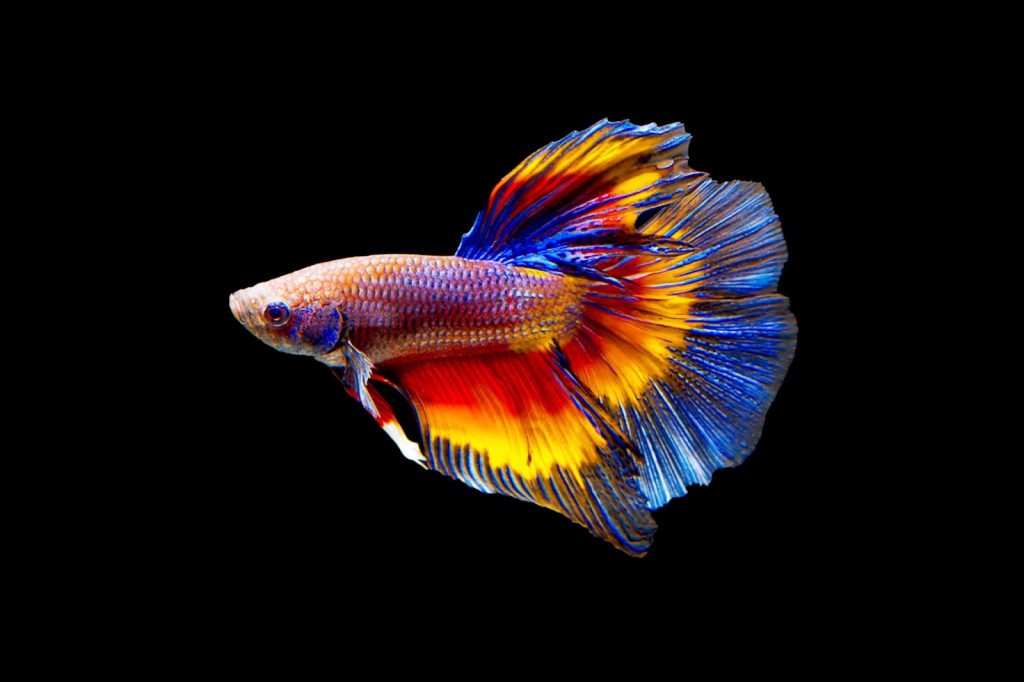The red betta fish, scientifically known as Betta splendens, is a popular freshwater fish species known for its vibrant red color and flowing fins. They are also commonly known as Siamese Fighting Fish, as they were originally bred in Thailand for fighting. However, today, they are more commonly kept as pets in aquariums.
Betta Fish have been around for over 150 years, and they originated in the rice paddies and shallow waters of Thailand, Cambodia, Laos, and Vietnam. In the early 19th century, the King of Siam (now Thailand) began collecting and using these fish in fights, which eventually became a popular pastime in the country.
In the late 1800s, a French explorer named Pierre Carbonnier discovered the Betta Fish and introduced them to the Western world. The Betta Fish soon became a popular pet among fish enthusiasts, and breeders began creating new colors and patterns.
Purpose of the Guide
This guide provides a detailed overview of the Red Betta Fish, including their characteristics, care, and maintenance. It is designed for beginners new to Betta Fish or those considering getting one as a pet. By the end of this guide, you should better understand what it takes to care for and maintain a healthy Red Betta Fish in your home aquarium.
Characteristics of Red Betta Fish
Red Betta Fish are known for their striking and vibrant red color, ranging from deep crimson to bright cherry red. They have long, flowing fins, which can be prone to tearing if not properly cared for. Their fins can also come in different shapes, such as round, spiky, or veiled.
Red Betta Fish are known for their aggressive behavior, particularly towards other male Betta Fish. They are territorial by nature and will fiercely defend their territory, which can lead to fights if they are kept in a tank with other males. They are also known for their interactive behavior, as they will often swim to the top of the tank to greet their owners and may even eat out of their hands.
Red Betta Fish can live for up to three years or more with proper care and maintenance. However, their lifespan can be shortened if they are kept in poor tank conditions or not properly fed and cared for.
Red Betta Fish require a tank that is at least 5 gallons in size, with a temperature range of 76-82 degrees Fahrenheit and a pH level between 6.5 and 7.5. They also require a filter and aeration system to keep the water clean and oxygenated. Regarding tank decor, Red Betta Fish prefer hiding places and plants, as well as a smooth substrate to prevent damage to their delicate fins. It is important to keep the tank clean and maintain proper water quality to prevent disease and ensure the health of your Red Betta Fish.
Types of Red Betta Fish
Solid Red Betta Fish
Solid Red Betta Fish is the most common type of Red Betta Fish. As the name suggests, it is solid red throughout its body and fins. This type of Betta Fish is also known as the Red Devil Betta.
Marble Betta Fish
Marble Betta Fish have a unique color pattern that resembles the marbling effect found in some types of stone. Their bodies have a mix of red, white, and black, and their fins can be any color. Marble Betta Fish can change their color pattern throughout their lifetime, making them an interesting and dynamic addition to any aquarium.
Butterfly Betta Fish
Butterfly Betta Fish have a solid color on their body but have a contrasting color on their fins, creating the appearance of butterfly wings. For example, a Red Butterfly Betta Fish would have a solid red body and white or clear fins with a red border.
Dragon Betta Fish
Dragon Betta Fish has a unique scale pattern that resembles the scales of a dragon. They have a solid body color, typically red or blue, and their scales have a metallic or iridescent sheen that makes them appear like dragon scales. Their fins can also have a unique pattern that complements their body color.
Koi Betta Fish
Koi Betta Fish have a distinct pattern that resembles the koi fish found in Japanese ponds. They have white or cream-colored bodies with red, black, or orange patches, and their fins can also have the same pattern. Koi Betta Fish can come in different colors, but the red and white variety is the most popular.
Overall, Red Betta Fish come in a variety of colors and patterns, each with unique characteristics and appearance. It is important to choose a type that you find visually appealing, and that fits your preferences.
Feeding and Nutrition
Types of Food
Red Betta Fish are omnivorous and require a balanced diet consisting of plant- and animal-based foods. They can be fed various foods, including pellets, flakes, freeze-dried or frozen foods, and live foods such as brine shrimp or bloodworms. It is important to choose high-quality fish food that is specifically formulated for Betta Fish, and that provides all the necessary nutrients and vitamins to keep them healthy.
Feeding Schedule
Red Betta Fish should be fed once or twice a day, with each feeding session lasting no more than two to three minutes. It is important to feed them small amounts of food at a time to prevent overfeeding, which can lead to obesity and other health problems. Red Betta Fish can also be trained to eat from your hand or to respond to a feeding bell or a specific feeding area in the tank.
Overfeeding and Underfeeding
Overfeeding can lead to several health problems, such as obesity, constipation, and poor water quality. Uneaten food can also decay in the tank, increasing ammonia levels, which can harm your fish. It is important to feed your Red Betta Fish small amounts of food at a time and to remove any uneaten food from the tank after feeding.
Underfeeding can also lead to health problems, as Red Betta Fish require a balanced diet to maintain health and vitality. Signs of underfeeding include lethargy, loss of color, and a lack of appetite. It is important to monitor your fish’s behavior and appearance to ensure they get enough food and adjust their feeding schedule accordingly.
Tank Setup and Maintenance
Red Betta Fish are relatively small, and they can thrive in a tank of at least 5 gallons. A larger tank can provide more swimming space and allow for a more natural environment, but it is important to avoid overcrowding the tank with too many fish or decorations.
Water Quality
Maintaining good water quality is essential for the health and well-being of Red Betta Fish. The ideal water temperature for Betta Fish is between 76 and 82 degrees Fahrenheit, and the pH level should be between 6.5 and 7.5. To keep the water clean and free from harmful substances, it is important to test the water regularly and perform partial water changes of 25-30% every two weeks.
Filtration and Aeration
A good filtration system is important for keeping the tank clean and healthy for Red Betta Fish. The filter should provide both mechanical and biological filtration, which removes debris and harmful substances from the water and promotes the growth of beneficial bacteria. Aeration can also help to improve water quality by increasing oxygen levels in the tank and promoting healthy gas exchange.
Decorations and Plants
Decorations and plants can provide Red Betta Fish with a natural and aesthetically pleasing environment. It is important to choose decorations and plants that are safe for Betta Fish and contain no sharp edges or toxic substances. Plants can also help improve water quality by absorbing harmful substances and producing oxygen.
Cleaning Schedule
Regular cleaning is important for maintaining good water quality and a healthy environment for Red Betta Fish. It is recommended to perform partial water changes of 25-30% every two weeks and to clean the tank and decorations with a gentle scrubber to remove any debris or algae buildup. It is also important to avoid using any harsh chemicals or soaps when cleaning the tank, as they can be harmful to your fish.
Common Health Issues and Treatments
Fin Rot
Fin rot is a common bacterial infection that affects the fins and tail of Red Betta Fish. It is caused by poor water quality, overcrowding, or stress. Symptoms include frayed or ragged fins, discoloration, and loss of fin tissue. Treatment options include improving water quality, reducing overcrowding, and administering antibiotics.
Velvet
Velvet is a parasitic infection that causes a yellow or gold dusting on the skin and fins of Red Betta Fish. It is caused by poor water quality, stress, and overcrowding. Symptoms include lethargy, loss of appetite, and clamped fins. Treatment options include improving water quality, reducing overcrowding, and administering antiparasitic medications.
Ich
Ich, also known as white spot disease, is a parasitic infection that causes small white spots on the skin and fins of Red Betta Fish. It is caused by poor water quality, stress, and overcrowding. Symptoms include lethargy, loss of appetite, and scratching against tank decorations. Treatment options include improving water quality, reducing overcrowding, and administering antiparasitic medications.
Dropsy
Dropsy is a bacterial infection that causes fluid buildup in the body cavity of Red Betta Fish, leading to bloating and swelling. It is caused by poor water quality, stress, and weakened immune systems. Symptoms include bloating, raised scales, and lethargy. Treatment options include improving water quality, reducing stress, and administering antibiotics.
Treatment Options
In addition to the specific treatment options listed above, it is important to maintain good water quality and reduce stress to prevent and treat health issues in Red Betta Fish. This can be achieved by performing regular water changes, avoiding overcrowding, and providing a balanced diet and a suitable environment. If your Red Betta Fish is showing signs of illness, it is important to seek the advice of a veterinarian or a qualified fish expert for proper diagnosis and treatment.
Breeding Red Betta Fish
Selecting Breeding Pair
To breed Red Betta Fish, it is important to select a breeding pair that is healthy, mature, and has desirable physical traits. It is recommended to choose a male and a female with similar body shapes and color patterns. It is also important to ensure that both fish are free from any illnesses or deformities.
Breeding Process
The breeding process for Red Betta Fish involves several steps. First, it is important to condition the breeding pair by feeding them a high-quality diet and providing a suitable environment. Once the female is ready to spawn, she will display a white spot on her belly, indicating that she is carrying eggs.
The male should be introduced into the breeding tank with the female to initiate breeding. The male will then build a bubble nest at the water’s surface. The female will lay her eggs, and the male will fertilize them and transfer them to the bubble nest.
After spawning, it is important to remove the female from the breeding tank to prevent her from eating the eggs or attacking the male. The male will then care for the eggs and the hatching fry.
Fry Care
Once the eggs hatch, the male will protect the fry and maintain the bubble nest. It is important to provide the fry with a suitable environment, including a small tank with clean, warm water and plenty of hiding places. The fry should be fed a high-quality diet, such as newly hatched brine shrimp or commercial food.
Potential Issues
Breeding Red Betta Fish can be a rewarding experience, but it is important to be aware of potential issues that may arise. These include:
- Egg Fungus: If the eggs become infected with fungus, they may turn white or become covered in a white film. To prevent this, it is important to maintain good water quality and remove any eggs that appear infected.
- Aggression: Male Red Betta Fish can become aggressive during breeding and may attack the female or other fish in the tank. It is important to closely monitor the breeding pair and separate them if necessary.
- Poor Hatching Rate: Not all eggs may hatch, or the fry may not survive due to poor water quality or inadequate care. It is important to provide the fry with a suitable environment and to feed them a nutritious diet to improve their chances of survival.
Conclusion
Caring for Red Betta Fish requires a suitable environment, a balanced diet, and regular maintenance. This includes selecting an appropriate tank size, maintaining good water quality, providing adequate filtration and aeration, and decorating the tank with suitable plants and decorations. Red Betta Fish also require a nutritious diet, including various foods and a feeding schedule that prevents overfeeding or underfeeding.
Keeping Red Betta Fish can be a rewarding experience, as they are known for their vibrant colors and unique personalities. They are also relatively low-maintenance and can be kept in small tanks, making them a great choice for beginners or those with limited space. Additionally, breeding Red Betta Fish can be a fun and educational experience, allowing owners to observe the natural behaviors of these fish.
Caring for Red Betta Fish requires effort and attention, but the rewards are well worth it. Owners can ensure that their Red Betta Fish live long, healthy lives by providing a suitable environment, a balanced diet, and regular maintenance. It is also important to be aware of potential health issues and to seek veterinary care if necessary.
For those interested in keeping Red Betta Fish, it is recommended that further research be done and consult with an experienced fishkeeper to ensure that all their needs are met. With proper care and attention, Red Betta Fish can make a beautiful and rewarding addition to any aquarium.




